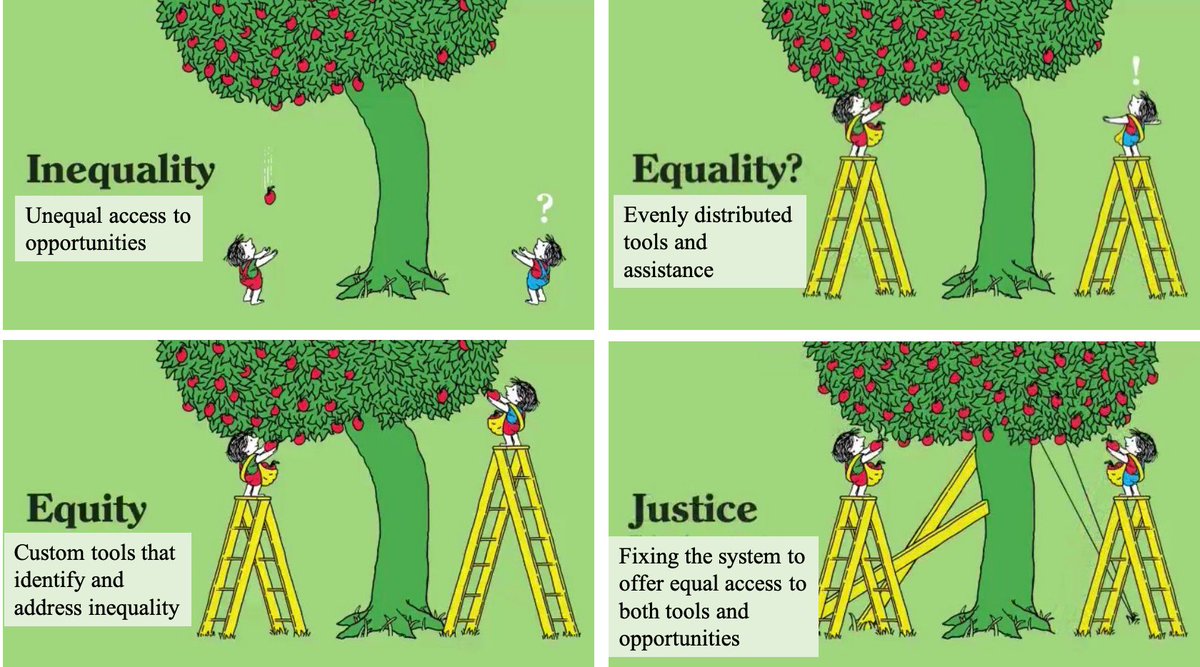This year’s theme for International Women’s Day (IWD) was #EmbraceEquity. Its aim was “to get the world talking about why equal opportunities aren’t enough.” And that means being clear about the difference between equality and equity: equality is giving everyone the same thing, while equity is giving each person what they need to be successful. At Serendis, we’re strong supporters of IWD and its vision of a gender equal world. But we’ve observed that the way corporate Australia addresses gender inequity could be hampering inclusion.
So, is equity really the right thing for companies to pursue right now, in order to advance women in the workplace? And if the answer is ‘no’, then how can we more fairly address gender inequity at work?
More on equality versus equity
The difference between equality and equity can be illustrated by the statement that “Equality is inviting a diverse range of people to the leadership table. Equity is giving all voices at that table the same weight.”
This visual representation also helps to highlight the difference:

*Illustration by Tony Ruth aka @lunchbreath
Equality is all about giving each person the same resources or opportunities, in an attempt to be ‘fair’. In contrast, the concept of equity acknowledges that existing systems (such as the way the tree above naturally leans) may favour certain individuals over others. Equity, then, is about providing some people with additional resources, to create equal outcomes.
Recognising differences in people’s resources and opportunities is important. But the problem is that inequity in the workplace – unlike the image above of two people picking apples – is often invisible. Although, the gender representation in leadership positions can be measured (at an aggregate level), much of the difference between how men’s and women’s leadership potential is assessed is caused by stereotypes and unconscious biases – which can’t be seen and are hard to quantify.
For example, say a company is hiring for a new role. The final two candidates are both very capable and have similar achievements. However, Candidate A is seen as aggressive and too direct, while Candidate B is seen as likable and with positive leadership skills. Candidate B gets the job. But what if Candidate A is a woman, and she feels she’s been unfairly judged as aggressive; that if she was a man she’d be seen as ‘assertive’? How can we prove there are unconscious biases and stereotypes at play? Of course, we can’t. Similarly, we will never know the extent to which a woman (or a man) is undermined by unconscious biases when applying for a promotion.
So, how can we address gender inequity in the corporate world?
Responding to gender inequity: quotas and other problems
Historically, organisations have responded to gender inequity by using blunt instruments like quotas or positive discrimination; dictating the number of women who should be appointed to a certain level in the organisation. From a high-level perspective, this makes sense. But at an individual level, quotas can be damaging, and there’s enormous room for error.
Quotas are often a lose-lose: women dislike being appointed/promoted because of their gender as it implies they may not merit the role, and men dislike quotas because they feel discriminated against based on their gender. Indeed, at Serendis we’re seeing a lot of men and women who are discontented with the current sole focus on gender diversity, and the use of quotas.
When it comes to gender equity, it’s a messy situation in corporate Australia right now because of three factors:
- Women still feel they experience stereotyping and unconscious bias, which hinders their progress to senior leadership positions;
- Men feel the push for gender equity discriminates against them, and
- The representation of women in senior roles is still moving at a glacial pace.
- Women experiencing stereotypes and unconscious bias
Women have plenty of reasons to feel they’re still not being given the same opportunities as men. The latest data from the Workplace Gender Equality Agency (WGEA), released in December 2022, shows that progress to close the gender pay gap between Australian men and women has stalled for the first time, with the gap stuck at 22.8 per cent. And the “Breaking the Norm” report from Deloitte Access Economics, published in November 2022, reported that Australia is falling behind on measures of gender equity: in the 16 years to 2022, Australia moved from 15th to 43rd on the World Economic Forum’s Global Gender Gap Index.
At the same time, unconscious biases against women still run rampant. Women continue to receive more feedback than men about their leadership style during performance assessments. Gender inequity is so embedded in performance feedback that if you ask AI tool ChatGPT to write a performance review, the result is “wildly sexist”.
- Men feeling discriminated against
While there’s no hard data to support men feeling discriminated against, there’s plenty of anecdotal evidence. At Serendis, for example, we regularly see men applying for roles, being told they have all the qualifications required but are unsuccessful because the company needed a woman in the role. That’s okay if it only happens once or twice. But there is such pressure right now for organisations to meet gender targets that this situation can – and does – happen several times in a row to men looking for work. These men feel it is incredibly unfair (not to mention ironic) to be rejected just because of their identity.
Unfortunately, this hinders inclusion. Why? Because when a person feels discriminated against, they seek support from others in the same situation, which creates more in-group behaviours and amplifies the discontent. While this phenomenon is largely silent for now – people know it would be career-damaging to speak up against gender diversity initiatives – it is real and concerning.
- Poor representation of women in senior roles
According to Deloitte’s Breaking the Norm report, only six per cent of ASX 300 CEOs are women. And the WGEA 2021-22 Employer Census found that although the number of female CEOs had risen from the previous year, still only 22 per cent of CEOs are women. The WGEA Census also found that men are more likely to hold managerial positions, even in female-dominated industries such as healthcare and education.
In terms of board representation, WGEA reported in December 2022 that:
- Only one in five governing boards are gender-balanced, while more than one in five boards have no women at all.
- Since 2014, the number of boards without women has dropped from 37 to 22 percent, but 72 per cent of boards are still comprised of a significant majority (over 60 per cent) of men.
- Less than one per cent of boards comprise only women.
Clearly, the current tools and strategies to achieve gender equity aren’t working. But what’s the solution?
A more constructive and sustainable response to gender inequity
While quotas have undoubtedly been helpful, they are a tool that should be used very carefully. Quotas are useful for graduate recruitment, ensuring that organisations are attracting male and female employees in equal representation at the most junior levels. In very large organisations, quotas can also be helpful in promoting the same number of men and women to different levels, when there’s a talent pool with enough gender diversity. But quotas aren’t helpful when hiring managers have to engineer gender diversity in their team while their organisation hasn’t focused on creating a culture of inclusion.
For sustainable, long-term solutions to gender inequity at senior leadership levels, organisations need to move beyond quotas and shift their focus to inclusion. An inclusive environment is one where leaders actively seek to attract, value and leverage diversity of thought. When leaders recognise the connection between diversity of thought and improved performance, they:
- Give men’s and women’s voices equal weight; and.
- Naturally seek to attract different people – creating an equitable ‘system’.
Going back to the tree illustration earlier in this article, the last quadrant, which depicts fairness, is one where the tree is fixed so it’s no longer leaning. Similarly, organisations need to place much more effort on fixing ‘the tree’ – the corporate system – to create sustainable change.
Leaders think that if they’re a nice, kind and fair person (and don’t we all think of ourselves that way?), they’re being inclusive. But the reality is that the human brain is not naturally inclined towards inclusion. Rather, we’re drawn to people who are similar to us, and we form stronger bonds with people of the same identity as ourselves. This means leaders need to learn the conscious skills of inclusion, and organisations need to equip their leaders to recognise and consciously override their biases (for example, ensuring the topic of bias is always discussed when making hiring or promoting decisions). Organisations must also hold leaders accountable for creating an environment where different voices are valued, particularly those who challenge groupthink. You can read more here about how leaders can behave more inclusively, and the nine behaviours of inclusive cultures which Serendis has identified.
Measuring inclusion will not be an easy road. But at Serendis, we believe it will be a more sustainable path to achieving gender equity. So that one day, we will no longer hear comments like this one, from CEO Anne Clarke Wolff, on a 2022 podcast about the wages of sexism: “People want to believe that women exit because the job has long hours or is difficult. When you interview women, they never say that… They leave because of the lack of inclusion.”



